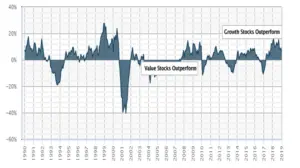Stocks and the Economy: Irrational Exuberance
When Federal Reserve chairman Alan Greenspan made his famous pronouncement on the stock market back in 1996, the economy was strong and the Internet bubble was just starting to inflate. In fact, “irrational exuberance” would seem to be a more fitting label for today’s market.
Between March 23 and June 8, the S&P 500 rose over 44%, putting it less than 5% shy of its all-time high set in February. Meanwhile, the Dow Jones Industrial Average topped 27,500, just 7% short of its record and the NASDAQ Composite hit new highs. Although markets have taken some jolts since then, stocks are still doing surprisingly well.1
The economy, however, presents a very different picture. Unemployment in the U.S. skyrocketed to 14.7% in April and then fell slightly to 13.3% in May, still the highest levels since the Great Depression. Institutional loan default rates are up sharply, and bankruptcy filings are expected to follow suit, especially among retailers. The Congressional Budget Office expects second quarter Gross Domestic Product (GDP) to tumble by 12%, its largest drop since the early 1930s, and the Federal Reserve has cautioned that it could take time for the economy to bounce back, especially if second-wave virus outbreaks emerge. In fact, many economists are calling for a drawn out recovery, with fits and starts, as secondary waves of infections keep some businesses shuttered and scare consumers away from stores and travel.
To put the disparity in perspective, consider some recent bear markets and their economic fallout. In the 2007-2009 financial crisis, the S&P 500 lost 56% of its value. Yet unemployment never topped 10%, and GDP fell only 2.5% in 2009. Or, consider the dotcom bust, when the S&P 500 fell 49% (and the NASDAQ Composite lost three quarters of its value). The ensuing economy saw unemployment top out at 6.3%, while annual GDP growth remained positive.
Clearly, the current market would seem to be at odds with economic reality. But there are several different factors at work here.
Stocks Are Not the Economy
As Nobel Prize winning economist, Paul Samuelson, famously quipped back in the 1960s: the stock market has predicted nine of the past five recessions. Paul Krugman, another Nobel laureate, suggests three rules when considering the economic implications of stock prices: “First, the stock market is not the economy. Second, the stock market is not the economy. Third, the stock market is not the economy.”2
As both men emphatically point out, the dynamics driving stocks differ from those driving the economy. The major market indexes such as the Dow Jones Industrial Average (DJIA) or the S&P 500 reflect a limited segment of the economy, and the majority of stocks are owned by a small percent of the population. The widely followed DJIA, for instance, is composed of just 30 blue-chip stocks. Even the broader S&P 500 index contains only the largest of U.S. companies. Small businesses, which represent the lion’s share of U.S. businesses and employ almost half of Americans working in the private sector, have little representation in stock indexes. Yet it is those smaller businesses, many with limited cash reserves, which are taking the biggest economic hit from the pandemic.
Stock index prices are also driven largely by constituent companies’ earnings and profits, which may have little to do with economic metrics such as unemployment. Furthermore, stocks are highly sensitive to interest rates and monetary policy changes, which typically take much longer to be felt in the economy.
Government Moves to Shore Up the Economy Have Been Unprecedented
The optimism of investors in the face of economic freefall may be justified in part by the bold steps taken by the Federal Reserve and Congress to stem the fallout from lockdowns and closings. The Federal Reserve has slashed interest rates, increased the money supply, and taken different measures to support capital markets. For its part, Congress has passed unprecedented stimulus legislation, boosting weekly unemployment checks by $600, and passing such bills as the CARES Act. Meanwhile, the Small Business Administration is also supporting businesses through its Paycheck Protection Program. Collectively, such moves — and many others by state and local governments — not only provide immediate relief to millions of companies and workers, they also send the message to investors that the government is willing to take whatever steps are necessary to get the economy back on track.
Stocks Are Still the Investment of Choice
Long before the coronavirus struck, anyone seeking return was turning to stocks. Yields on bonds and cash had been historically low for years. Now, with recent interest rate cuts, that trend is more pronounced than ever. As of June 1, the interest rate on 10-year U.S. government bonds was only 0.66%, down from more than 3% in late 2018.3 After inflation is factored in, that works out to a negative return. Meanwhile, higher-yield bonds are riskier than ever as cash-strapped issuers may struggle to make interest payments. So it’s no wonder that capital continues to gravitate toward stocks — even in the face of economic turmoil — since they appear to be the only game in town with potential for return-hungry investors.
The Road Ahead
Whether stocks will continue on a divergent path from the economy is anyone’s guess. Ultimately, the longer-term health of both the stock market and the economy will largely hinge on the success in slowing and stopping the pandemic. But any resolution will take time, and there will likely be bumps in the road.
Also keep in mind that trying to time the market’s ups and downs is a losing game. Anyone heeding Greenspan’s warning back in 1996 would have missed out on three of the best-performing years in recent stock market history. So stick to your plan, expect volatility, and consult with a professional before making any major financial decisions.
Notes
1Google Finance.
2New York Times, Crashing Economy, Rising Stocks: What’s Going On?, April 30, 2020.
3U.S. Department of the Treasury, Daily Treasury Yield Curve Rates, June 1, 2020.
This material was prepared by LPL Financial. This material is for general information only and is not intended to provide specific advice or recommendations for any individual. There is no assurance that they views or strategies discussed are suitable for all investors or will yield positive outcomes. Investing involves risks including possible loss of principal. Any economic forecasts set forth may not develop as predicted and are subject to change.
References to markets, asset classes, and sectors are generally regarding the corresponding market index. Indexes are unmanaged statistical composites and cannot be invested into directly. Index performance is not indicative of the performance of any investment and do not reflect fees, expenses or sales charges. All performance referenced is historical and is no guarantee of future results.
The Standard and Poor’s 500 Index (S&P500) is a capitalization-weighted index of 500 stocks designed to measure performance of the broad domestic economy through changes in the aggregate market value of 500 stocks representing all major industries.
Dow Jones Industrial Average is the most widely used indicator of the overall condition of the stock market, a price-weighted average of 30 actively traded blue chip stocks, primarily industrials. The 30 stocks are chosen by the editors of the Wall Street Journal. The Dow is computed using a price-weighted indexing system, rather than the more common market cap-weighted indexing system.
The NASDAQ-100 is composed of the 100 largest domestic and international non-financial securities listed on the NASDAQ Stock Market. The index reflects companies across major industry groups including computer hardware and software, telecommunications, retail/wholesale trade and biotechnology, but does not contain securities of financial companies.
Gross Domestic Product (GDP) is the monetary value of all the finished goods and services produced within a country’s borders in a specific time period, through GDP is usually calculated on an annual basis. It includes all of private and public consumption, government outlays, investments and exports less imports that occur within a defined territory.












